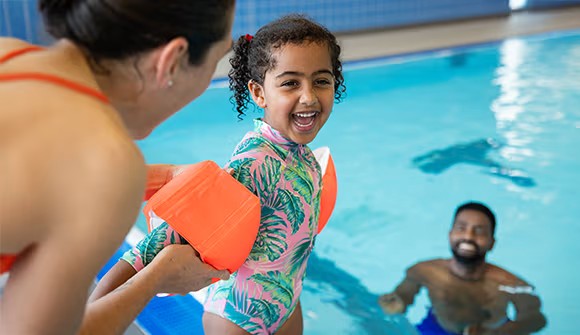Family Summer Safety Tips: Making the Most of South Florida’s Season

Summer in South Florida means longer days, exciting adventures, and plentiful opportunities for family fun.
While you’re already mindful of keeping your loved ones safe, a few seasonal reminders can help ensure everyone enjoys the sunshine months to the fullest. These family summer safety tips aren’t about restricting fun but maximizing it by staying prepared and confident in your outdoor adventures.
Sun Safety That Works for Real Families
We all know SPF 30+ is essential, but let’s talk practical application. Make sunscreen part of your morning routine by keeping bottles by the door, in the car, and in your beach bag. The “sunscreen before getting dressed” trick works wonders for squirmy toddlers, and teens might actually remember to reapply if they have their own personal tube.
Try the shadow game: Teach kids to check their shadow—if it’s shorter than they are, it’s peak sun time and they need extra protection or indoor activities. This simple rule helps them develop sun awareness without constant reminders from you.
For family bike rides or playground visits, those UV-protective rash guards aren’t just for the beach. They’re game-changers for active kids who hate stopping to reapply sunscreen every hour during outdoor fitness activities.
Water Safety Beyond the Basics
Whether you’re at community pools, backyard gatherings, or South Florida’s gorgeous beaches, water safety extends beyond swimming skills. The buddy system works at every age—even teens benefit from having someone who knows their plans and timeline.
Pool party hosting tip: Designate one adult as the “water watcher” for 15-minute shifts. This person has one job only—watching the water. No phones, no conversations, just active supervision. It takes the pressure off everyone and ensures constant vigilance.
For backyard pools, that fostering independence approach applies here, too. Teach kids to be safety leaders by having them help younger siblings with life jackets or by calling out unsafe behaviors they notice.
Beach and freshwater safety: Before hitting the waves or exploring canal areas, walk the perimeter together and point out any hazards, currents, or designated swimming areas. Make it a family exploration rather than a safety lecture.
Managing Mosquitoes Like a Local
South Florida’s mosquito population requires strategy year-round, but summer intensifies the challenge. Peak mosquito hours typically align with dawn and dusk, so plan active outdoor time for mid-morning or late afternoon when possible.
Repellent strategies that work: Let kids choose their preferred application method—spray, lotion, or wipes—so they’re more likely to cooperate with reapplication. Consider family-friendly options with picaridin, which works as effectively as DEET but feels less harsh on sensitive skin.
Timing activities: Those afternoon thunderstorms actually provide natural mosquito relief. Plan creative indoor activities during peak mosquito hours, then emerge for outdoor fun when conditions improve.
Smart Heat Management for Active Families
South Florida heat requires strategy, not avoidance. Early morning adventures and late afternoon activities become precious family time when you’re working around the sun’s intensity.
Hydration can be fun: Freeze fruit in ice cube trays for flavored water, or let kids choose their own special water bottles that they’re excited to use. The goal is to make hydration appealing, not nagging about it constantly.
Cool-down stations: Set up a rotation of cooling activities—sprinkler time, followed by indoor crafts, then maybe some shaded outdoor exploration. Kids stay engaged while their bodies regulate temperature naturally, supporting both physical wellness and mental wellness.
For families without central air, create cross-breezes with fans, use cooling towels during outdoor work, and remember that sometimes the best family activity is simply enjoying a cold treat together in the shade.
Lightning Safety and Storm Planning
Those afternoon thunderstorms are a South Florida summer staple, but they require respect and preparation. The “30-30 rule” applies everywhere: if thunder follows lightning by 30 seconds or less, seek shelter and wait 30 minutes after the last thunder before resuming outdoor activities.
Water activities and lightning: This is non-negotiable—get everyone out of pools, beaches, and any water activity at the first sign of lightning, even if rain hasn’t started. Water conducts electricity, making it extremely dangerous during storms.
Planning around storm patterns: Most South Florida families learn to read the sky and plan accordingly. Morning beach trips, midday indoor activities, and evening outdoor time often work better than fighting typical storm schedules.
Indoor backup plans: Keep a rotation of engaging indoor activities ready for storm days. These moments can become unexpected opportunities for family bonding and creativity.
Exploring South Florida’s Diverse Parks Safely
Our region offers incredible variety—from coastal beaches to inland nature preserves to neighborhood recreational parks. Each environment has unique considerations.
Beach and coastal parks: Beyond sun and water safety, teach kids to respect marine life and stay aware of rip currents. Many coastal parks post daily conditions that help families plan their visit timing.
Inland parks and nature preserves: Freshwater areas like canals and swamps require different awareness. Stay on designated paths, respect wildlife from a distance, and remember that still water often means more mosquitoes.
Recreational parks: Playground equipment gets scorching hot in the summer sun. The “hand test” works—if the equipment is too hot for your hand, it’s too hot for kids. Early morning or late afternoon visits work best, and splash pads provide perfect relief.
Before exploring new areas, involve kids in the planning process—checking park websites together, discussing what to bring, and setting realistic expectations builds independence skills.
Summer Home Safety That Flows Naturally
With kids home more often, your house dynamics change. Rather than adding rules, consider adjusting routines. Kitchen activities increase, so involve kids in food safety naturally—teaching proper handwashing while cooking together, or having them help identify when food needs refrigeration.
Pool maintenance as a family responsibility: Older kids can learn to test water chemical levels and understand pool safety from a maintenance perspective. It’s practical life skills disguised as family chores.
For families with backyard pools, that constant supervision extends to making sure gates and alarms function properly. Make it part of your weekly routine rather than a daily worry, supporting family mental wellness by reducing anxiety.
Making Safety Social
Connect with your community—knowing your neighbors creates natural safety networks. Kids benefit from having multiple trusted adults they can turn to, and parents gain peace of mind knowing extra eyes are looking out for everyone.
Neighborhood safety shares: Coordinate with other families for beach days or pool parties. More adults mean better supervision, and kids often listen better to safety reminders when they come from different voices.
This community approach also supports parent mental health—sharing safety responsibilities reduces individual stress while building stronger neighborhood connections.
Embracing Summer Safely
The goal isn’t perfect safety—it’s confident, prepared families who can enjoy everything South Florida summer offers. The best summer safety happens when families feel prepared, not anxious. When everyone knows the plan, understands their role, and feels equipped to handle situations that arise, family adventures become more relaxed and enjoyable for everyone.
Your kids are already learning independence and responsibility. Summer just gives them more opportunities to practice these skills while making memories that last long after the season ends.

